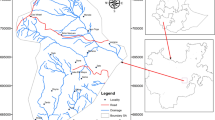Abstract
A logistic regression model is developed within the framework of a Geographic Information System (GIS) to map landslide hazards in a mountainous environment. A case study is conducted in the mountainous southern Mackenzie Valley, Northwest Territories, Canada. To determine the factors influencing landslides, data layers of geology, surface materials, land cover, and topography were analyzed by logistic regression analysis, and the results are used for landslide hazard mapping. In this study, bedrock, surface materials, slope, and difference between surface aspect and dip direction of the sedimentary rock were found to be the most important factors affecting landslide occurrence. The influence on landslides by interactions among geologic and geomorphic conditions is also analyzed, and used to develop a logistic regression model for landslide hazard mapping. The comparison of the results from the model including the interaction terms and the model not including the interaction terms indicate that interactions among the variables were found to be significant for predicting future landslide probability and locating high hazard areas. The results from this study demonstrate that the use of a logistic regression model within a GIS framework is useful and suitable for landslide hazard mapping in large mountainous geographic areas such as the southern Mackenzie Valley.





Similar content being viewed by others
References
Aylsworth JM, Duk-Rodkin A, Robertson T, Traynor JA (2000) Landslides of the Mackenzie valley and adjacent mountainous and coastal regions. In: Dyke LD, Brooks GR (Eds) The physical environment of the Mackenzie Valley, Northwest Territories: a base line for the assessment of environmental change. Natural Resources Canada, Ottawa, pp 167–176
Carrara A, Cardinali M, Guzzetti F, Reichenbach P (1995) GIS technology in mapping landslide hazard. In: Carrara A, Guzzetti F (Eds) Geographical information systems in assessing natural hazards, advances in natural and technological hazards research. Kluwer Academic Publishers, Dordrecht, The Netherlands, pp 135–176
Chung ChF, Fabbri AG, van Westen CJ (1995) Multivariate regression analysis for landslide hazard zonation. In: Carrara A, Guzzetti F (Eds) Geographical information systems in assessing natural hazards, advances in natural and technological hazards research. Kluwer Academic Publishers, Dordrecht, The Netherlands, pp 107–134
Donati L, Turrini MC (2002) An objective method to rank the importance of the factors predisposing to landslide with the GIS methodology: application to an area of the Apennines (Valnerina; Perugia, Italy). Eng Geol 63:277–289
Douglas RJW, Norris DK (1961a) Camsell Bend and Root River Map – areas, District of Mackenzie, Northwest Territories 95J,K. Department of Mines and Technical Surveys, Canada, Ottawa, p 36
Douglas RJW, Norris DK (1961b) Geology (1:250,000), Map 1375A, Camsell Bend, District of Mackenzie. Geological Survey Canada, Ottawa
Environment Canada (2004) Canadian climate normals 1971–2000. Available via: http://www.climate.weatheroffice.ec.gc.ca/climate_normals/results_e.html. Cited 29 Aug 2006
Guzzetti F, Carrara A, Cardinali M, Peichenbach P (1999) Landslide hazard evaluation: a review of current techniques and their application in a multi-scale study, Central Italy. Geomorphology 31:181–216
Hansen A (1984) Landslide hazard analysis. Slope instability. In: Brunsden D, Prior DB (Eds) Slope instability. John Wiley & Sons Ltd, New York, pp 523–602
Hawes RJ (1975) Geology (1:125,000), Map 9-1978 Camsell Bend, District of Mackenzie. Geological Survey Canada, Ottawa
Hosmer DW, Lemeshow S (2000) Applied logistic regression. John Wiley & Sons, Inc., 375 pp
Naranjo JL, van Western CJ, Soeters R (1994) Evaluating the use of training areas in bivariate statistical landslide hazard analysis: a case study in Colombia. J Int Inst Aerospace Surv Earth Sci 1994–3:292–300
Soeters R, van Westen CJ (1996) Slope instability recognition, analysis, and zonation. In: Keith Turner A, Schuster RL (Eds) Landslide investigation and mitigation. Special report 247. National Academy Press, Washington, D.C., pp 130–132
SPSS Inc. (1999) SPSS Base 10.0 for Windows user’s guide. SPSS Inc., Chicago, IL
Van Westen CJ (1994) GIS in landslide hazard zonation: a review, with example from the Andes of Colombia. In: Price MF, Heywood DI (Eds) Mountain environments & geographic information systems. Taylor & Francis Ltd, Great Britain, pp 135–165
Acknowledgements
This research was partially funded by a Natural Science and Engineering Research Council of Canada (NSERC) Discovery Grant awarded to Dr. Wang. The Landsat TM image was obtained from GeoGratis, Natural Resources Canada. The authors greatly acknowledge Professors John J. Claque and Paul M. Santi for their valuable comments on the manuscript.
Author information
Authors and Affiliations
Corresponding author
Rights and permissions
About this article
Cite this article
Chen, Z., Wang, J. Landslide hazard mapping using logistic regression model in Mackenzie Valley, Canada. Nat Hazards 42, 75–89 (2007). https://doi.org/10.1007/s11069-006-9061-6
Received:
Accepted:
Published:
Issue Date:
DOI: https://doi.org/10.1007/s11069-006-9061-6



